Table of Contents
- Introduction
- Editor’s Choice
- Global Champagne Market Overview
- Leading Champagne and Wine Brands Statistics
- Top Champagne Consuming Nations
- Per Capita Expenditure on Champagne in Various Nations
- Top Ten Champagne-Importing Nations
- Top Ten Champagne Exporting Nations
- Nutritional Components of Champagne
- Demographics of Champagne Consumers Statistics
- Consumer Attitudes Towards Champagne Statistics
- Regulations for Champagne in Various Nations Statistics
- Recent Developments
- Conclusion
- FAQs
Introduction
Champagne Statistics: Champagne, an emblem of sophistication and refinement, epitomizes sparkling wine crafted exclusively in France’s Champagne region.
Influenced by factors like soil, climate, and grape varieties—Chardonnay, Pinot Noir, and Pinot Meunier—it embodies the region’s unique terroir.
Through the traditional méthode champenoise, Champagne undergoes secondary fermentation in the bottle, creating its iconic bubbles.
Classified by sweetness levels from bone-dry Brut Nature to sweet Doux, it offers diverse styles to suit every palate.
Whether enjoyed as a non-vintage blend or a prestigious cuvée, Champagne captivates with its elegance and complexity. Best served chilled in narrow flutes, it pairs beautifully with various dishes.
While its influence spans globally, only wines from the Champagne region can legally bear its name. Understanding these basics enriches one’s appreciation of Champagne’s timeless allure.
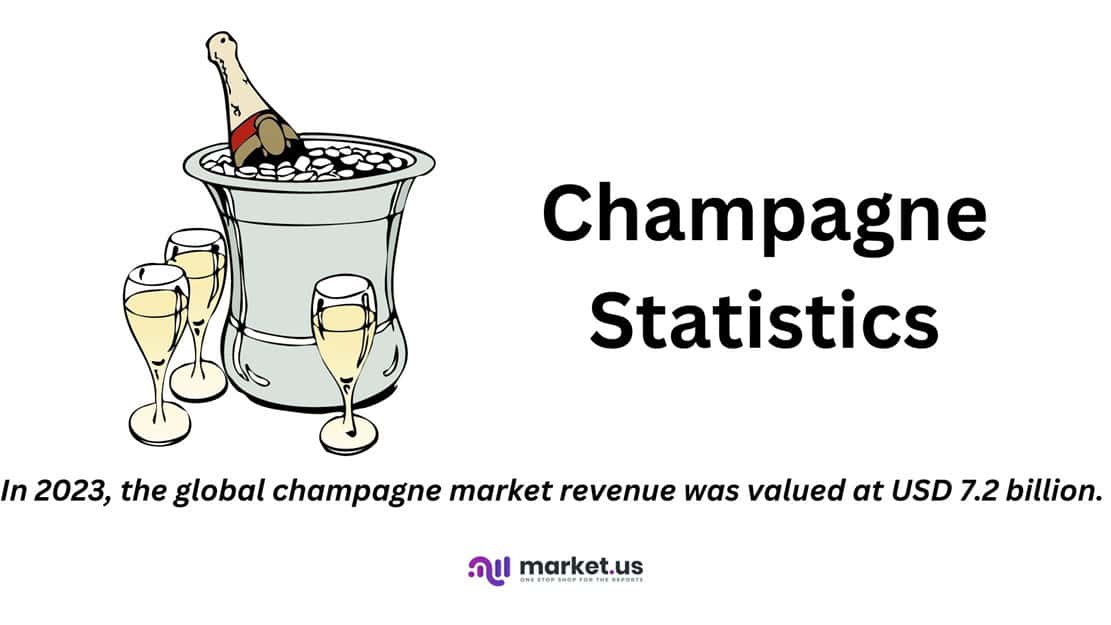
Editor’s Choice
- In 2023, the global champagne market revenue was valued at USD 7.2 billion.
- In 2023, increases were noted in all categories: Prestige Cuvee (USD 1.90 billion), Blanc de Noirs (USD 1.67 billion), Blanc de Blancs (USD 1.14 billion), Rosé Champagne (USD 0.84 billion), Brut Champagne (USD 0.61 billion), and Demi-Sec (USD 1.44 billion).
- The off-trade channel holds a dominant position, accounting for 75% of the market share.
- Leading the Brand list in 2023 was Moët & Chandon. Valued at $1,275 million, reflecting its preeminent status in the industry.
- France led the way with a significant consumption of 138.3 million bottles in 2022, underscoring its cultural affinity for champagne.
- Luxembourg led the rankings with the highest per capita expenditure of Champagne at €14.7. Indicative of its high standard of living and luxury consumption habits.
- In 2022, the United States led the list of top champagne-importing nations. Bringing in 34.1 million bottles valued at approximately 793.5 million EUR. Marking it as the highest spender on champagne imports.
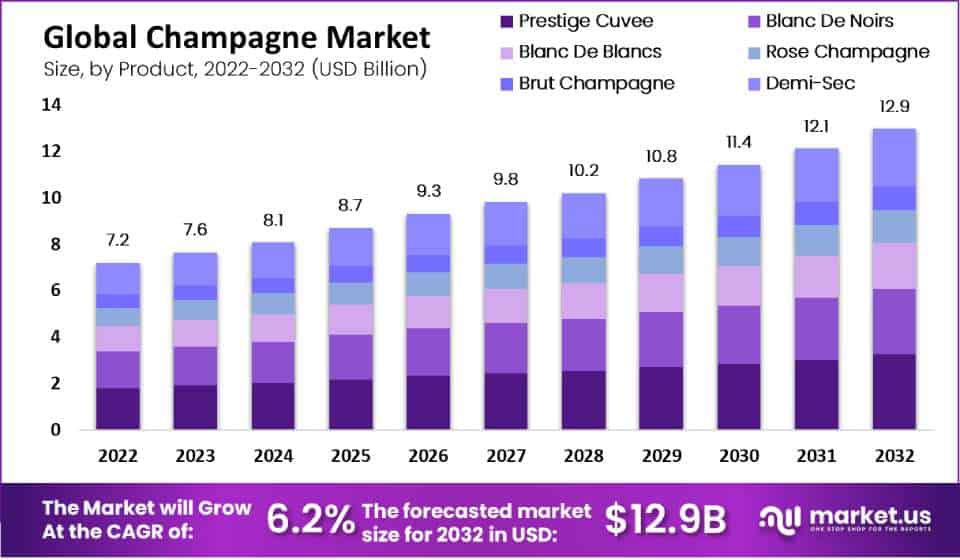
Global Champagne Market Overview
Global Champagne Market Size Statistics
- The global champagne market has demonstrated steady growth in revenue from 2022 to 2032 CAGR of 6.2%.
- In 2022, the market was valued at USD 7.2 billion, and it has incrementally increased to USD 7.6 billion in 2023.
- The trend of growth is projected to continue, with market revenue reaching USD 8.1 billion in 2024, USD 8.7 billion in 2025, and USD 9.3 billion by 2026.
- As the market progresses, a further rise is anticipated. With values estimated at USD 9.8 billion in 2027, USD 10.2 billion in 2028, and USD 10.8 billion in 2029.
- By the end of the decade, the market is expected to surge to USD 11.4 billion in 2030. With a substantial increase to USD 12.1 billion in 2031, culminating at USD 12.9 billion by 2032.
- This trajectory underscores a robust and expanding champagne market over the forecast period.
(Source: market.us)
Take advantage of our unbeatable offer - buy now!


Global Champagne Market Size – By Product Statistics
- The global champagne market is forecasted to grow significantly from 2022 to 2032 across various product segments.
- In 2022, the total market revenue stood at USD 7.2 billion, with Prestige Cuvee generating USD 1.80 billion, Blanc de Noirs USD 1.58 billion, Blanc de Blancs USD 1.08 billion, Rosé Champagne USD 0.79 billion, Brut Champagne USD 0.58 billion, and Demi-Sec USD 1.37 billion.
- By 2023, these figures rose to USD 7.6 billion overall. With increases noted in all categories: Prestige Cuvee (USD 1.90 billion), Blanc de Noirs (USD 1.67 billion), Blanc de Blancs (USD 1.14 billion), Rosé Champagne (USD 0.84 billion), Brut Champagne (USD 0.61 billion), and Demi-Sec (USD 1.44 billion).
- The upward trajectory is expected to continue, with the market reaching USD 8.1 billion in 2024, further climbing to USD 8.7 billion in 2025, and hitting USD 9.3 billion in 2026.
- Prestige Cuvee, Blanc de Noirs, and other categories are also anticipated to see parallel growth during this period. By 2027, the market is projected to reach USD 9.8 billion. Followed by an increase to USD 10.2 billion in 2028, USD 10.8 billion in 2029, and further growth to USD 11.4 billion by 2030.
- The growth trajectory continues, with the market expanding to USD 12.1 billion in 2031 and culminating at USD 12.9 billion by 2032.
- In each respective year, contributions from each product category, such as Prestige Cuvee, Blanc de Noirs, Blanc de Blancs, Rosé, Brut, and Demi-Sec, continue to enhance the overall market size. Indicating a strong and dynamic growth across the board in the champagne sector.
(Source: market.us)
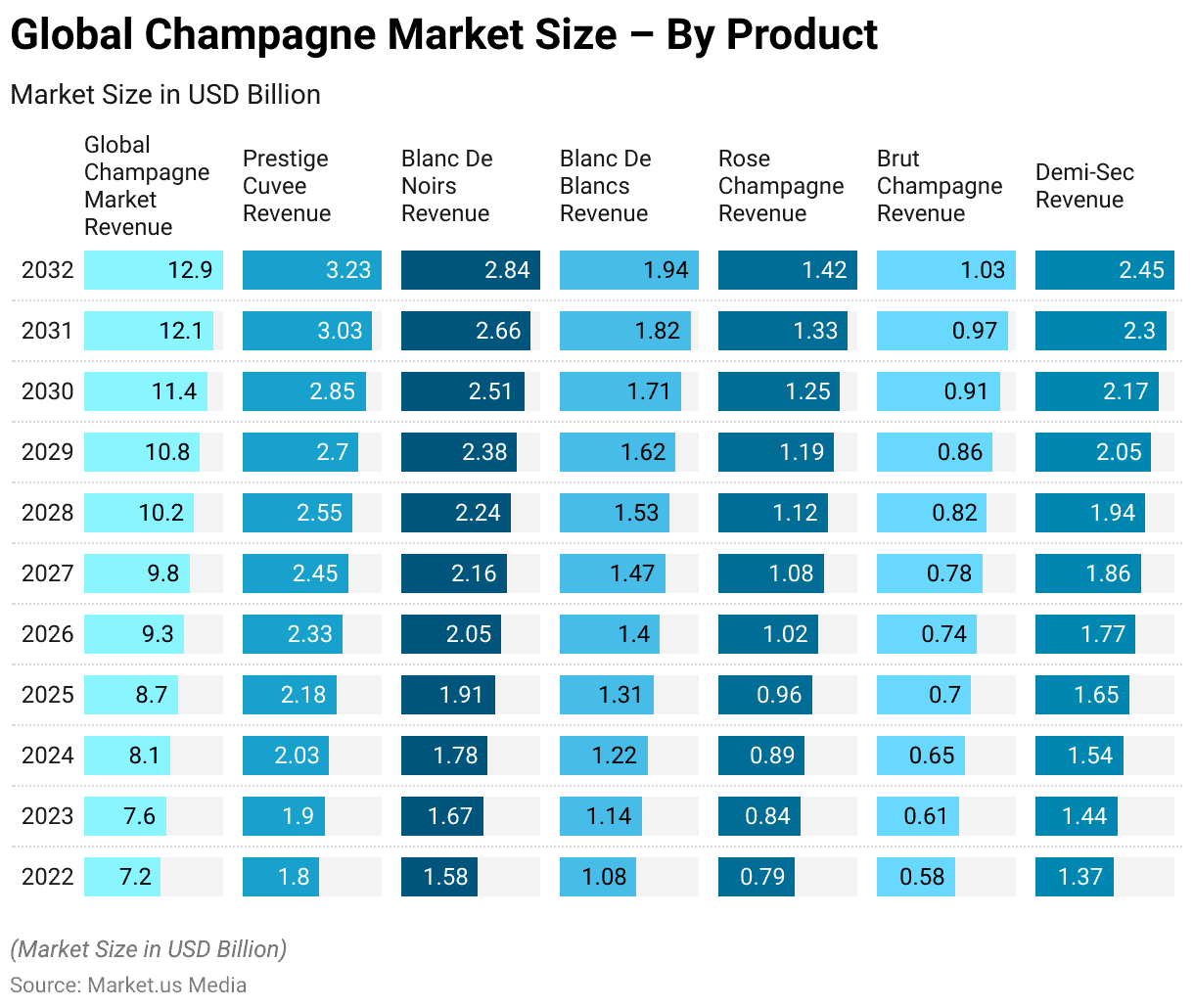
Global Champagne Market Share – By Distribution Channel Statistics
- A significant division between off-trade and on-trade channels characterizes the distribution of the champagne market.
- The off-trade channel holds a dominant position, accounting for 75% of the market share. This segment includes sales through retail outlets like supermarkets, liquor stores, and other retail locations where consumers purchase champagne for personal consumption off the premises.
- On the other hand, the on-trade channel, which encompasses venues such as restaurants, bars, and clubs where champagne is consumed on the premises, represents 25% of the market.
- This distribution reflects the prevailing consumer purchasing behaviors and market dynamics within the champagne industry.
(Source: market.us)

Leading Champagne and Wine Brands Statistics
- In 2023, the landscape of the global champagne and still wine market was dominated by several key brands, each distinguished by its brand value in millions of U.S. dollars.
- Leading the list was Moët & Chandon, valued at $1,275 million, reflecting its preeminent status in the industry.
- Following closely was Changyu, a prominent brand with a value of $1,053 million, and Chandon, which held a brand value of $1,011 million.
- Veuve Clicquot also featured prominently, with a valuation of $942 million. Dom Perignon, renowned for its luxury offerings, was valued at $750 million.
- Barefoot came next with a value of $742 million, closely followed by Penfold’s at $659 million.
- Beringer, with a brand value of $461 million, Concha y Toro, at $368 million, and Jacob’s Creek, at $313 million, rounded out the list of top global brands based on their market valuation, illustrating the competitive and diverse nature of the wine and champagne industry.
(Source: Statista)
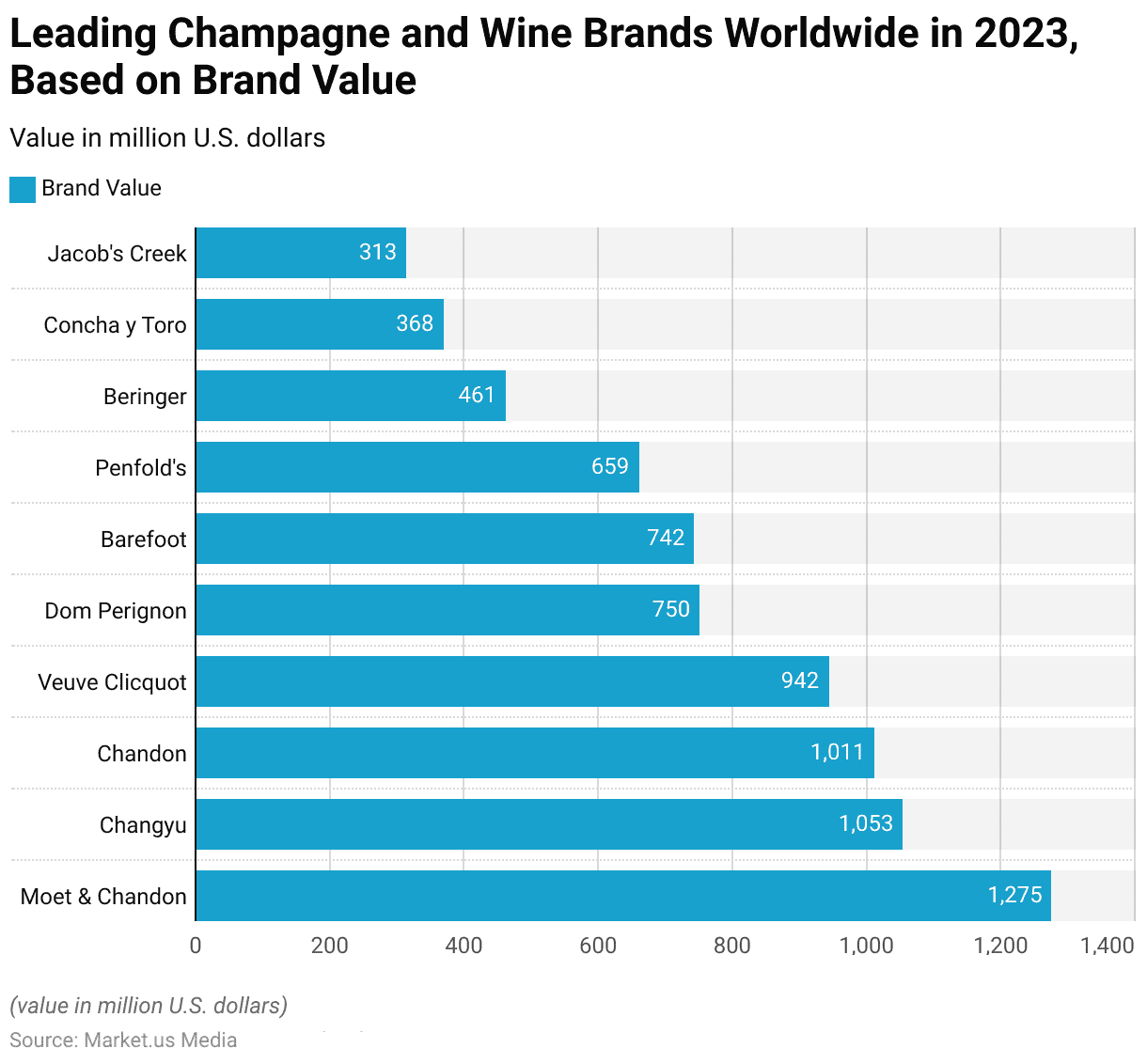
Top Champagne Consuming Nations
- In 2022, the consumption of champagne across various countries highlighted both established and emerging markets for this prestigious beverage.
- France led the way with a significant consumption of 138.3 million bottles, underscoring its cultural affinity for champagne.
- The United States followed as a distant second, consuming 33.7 million bottles, reflecting its large market size and luxury consumption trends.
- The United Kingdom was next, with 28 million bottles consumed, showcasing its longstanding appreciation for champagne.
- Japan also showed notable consumption at 16.6 million bottles, followed by Germany with 12.2 million bottles, indicating a strong market presence in these economies.
- Italy and Australia were close competitors in the champagne market, consuming 10.6 million and 10.5 million bottles, respectively. Belgium also demonstrated a solid demand with 10.3 million bottles.
- Switzerland and Spain rounded out the list with 6.4 million and 4.9 million bottles, respectively, illustrating their niche but significant markets for champagne.
- These figures highlight the global appeal and diverse markets for champagne across different regions.
(Source: Yahoo Finance)

Per Capita Expenditure on Champagne in Various Nations
- In 2020, per capita expenditure on champagne varied significantly across different countries. Reflecting varying levels of affluence and cultural appreciation for this luxury beverage.
- Luxembourg led the rankings with the highest per capita expenditure at €14.7. Indicative of its high standard of living and luxury consumption habits.
- Belgium followed with a substantial expenditure of €12.2 per person. While Switzerland also showed a strong affinity for champagne, with an expenditure of €10.87 per person.
- Hong Kong, representing a major Asian market, had a per capita expenditure of €6.13. Showcasing its growing luxury sector.
- Sweden and Denmark in Scandinavia recorded expenditures of €5.32 and €5.1, respectively. Further highlighting Europe’s dominant position in champagne consumption.
- The United Kingdom, is a traditionally strong market for champagne. Had a per capita spending of €4.96, closely followed by Australia at €4.89.
- Norway rounded out the list with an expenditure of €3.64 per person. Demonstrating the widespread appreciation and varying levels of investment in champagne across different economies and cultures.
(Source: The Wine Guard)

Top Ten Champagne-Importing Nations
- In 2022, the United States led the list of top champagne-importing nations, bringing in 34.1 million bottles valued at approximately 793.5 million EUR, marking it as the highest spender on champagne imports.
- The United Kingdom followed closely, importing 29.9 million bottles with a total value of 503.6 million EUR.
- Japan was also a significant importer, with 13.8 million bottles imported at a value of 354.5 million EUR.
- Germany and Belgium rounded out the top five, importing 11.1 and 10.3 million bottles valued at 201.9 million EUR and 200.1 million EUR, respectively.
- Australia, Italy, and Switzerland were also notable importers, with volumes of 9.9, 9.2, and 6.1 million bottles and values of 166.9 million EUR, 159.9 million EUR, and 125.6 million EUR, respectively.
- Spain and the Netherlands completed the top ten, importing 4.4 million bottles (94.0 million EUR) and 3.9 million bottles (79.7 million EUR), respectively.
- These figures reflect a strong global demand for champagne, underscoring its status as a luxurious and sought-after commodity in various international markets.
(Source: Champagne Wines)

Top Ten Champagne Exporting Nations
- In terms of champagne exports, France stands out as the top exporter, with a substantial shipment volume of 83,098 units, emphasizing its leading role in the global champagne industry.
- China follows as the second-largest exporter, with a significant shipment volume of 52,119 units. India ranks third, contributing 32,094 units to the international champagne market.
- Germany and Vietnam are also prominent exporters, shipping 17,993 and 17,426 units, respectively. Italy closely trails with 17,045 units exported.
- The list continues with Spain, the Netherlands, and Belgium, which exported 12,450, 11,990, and 11,197 units, respectively.
- The United States rounds out the top ten, exporting 9,145 units of champagne, showcasing a diverse array of significant players in the global champagne export market.
- These figures illustrate the dynamic nature of the champagne trade, highlighting the major contributions of these nations to the global distribution of this luxury beverage.
(Source: Volza)
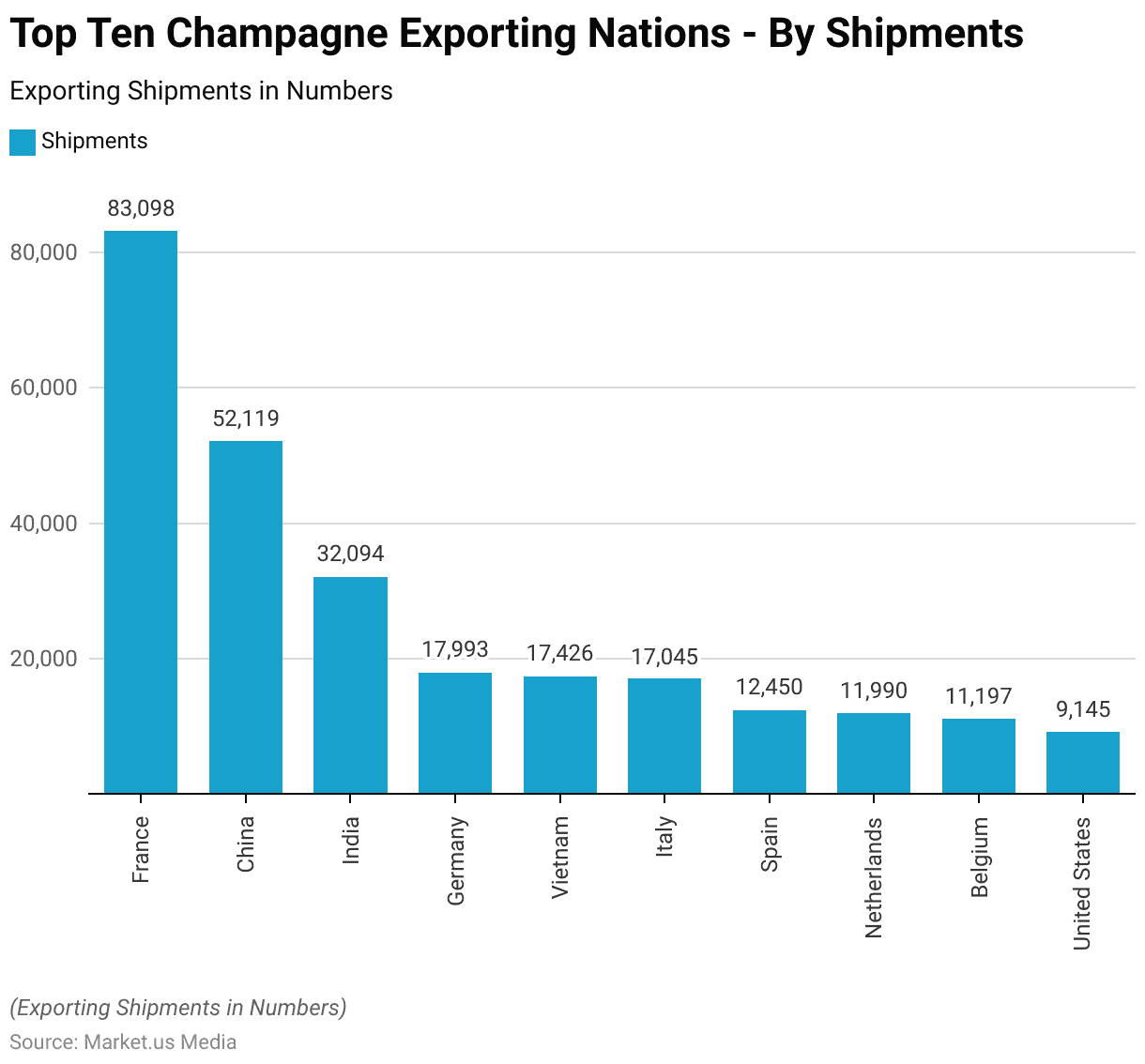
Nutritional Components of Champagne
- A standard serving of champagne offers small quantities of various micronutrients.
- It contains 5 mg of sodium, which is essential for fluid balance in the body.
- Potassium, another crucial electrolyte, is present in a relatively higher amount of 99 mg, supporting heart function and muscle contractions.
- Champagne also provides 14 mg of calcium, which is beneficial for bone health and muscular functions.
- Additionally, there is a modest amount of iron, about 0.4 mg, which is important for oxygen transport in the blood.
- However, it is important to note that champagne does not contain Vitamin D, Vitamin A, or Vitamin C, as their levels are recorded at 0 IU and 0 mg, respectively, indicating no contribution to those particular nutrients from a standard serving of champagne.
(Source: Champagne Club)
Demographics of Champagne Consumers Statistics
By Age and Gender
- The perceived age profile of consumers of Champagne, Prosecco, and Cava varies across varieties and genders.
- For Champagne, male drinkers are predominantly in their 40s, with 43% representation, followed by those in their 30s at 22%, and those 50 and older at 15%.
- Only 2% of male Champagne drinkers are in their 20s, while 18% do not fall into a specific age profile.
- Female champagne drinkers show a higher percentage in their 30s at 29%, 36% in their 40s, and fewer in the 50 and older group at 12%. About 4% are in their 20s and 20% have no specific age profile.
- Prosecco drinkers show a younger demographic, especially among females, with 16% in their 20s and 35% in their 30s.
- Male Prosecco drinkers are similar, with 14% in their 20s and 35% in their 30s. The representation decreases significantly for older age groups, with only 10% of males and 9% of females over 50. Both genders have approximately 22-23% of consumers without a specific age profile.
- Cava consumers present a more evenly distributed age profile, especially among females, with 8% in their 20s, 18% in their 30s, 18% in their 40s, and 18% aged 50 and above.
- Males show slightly less uniformity, with 8% in their 20s, 17% in their 30s, 21% in their 40s, and 17% over 50.
- Notably, both male and female Cava drinkers have a high percentage, 37%, with no specific age profile, suggesting a broad appeal across different age groups.
(Source: Formes De Luxe)
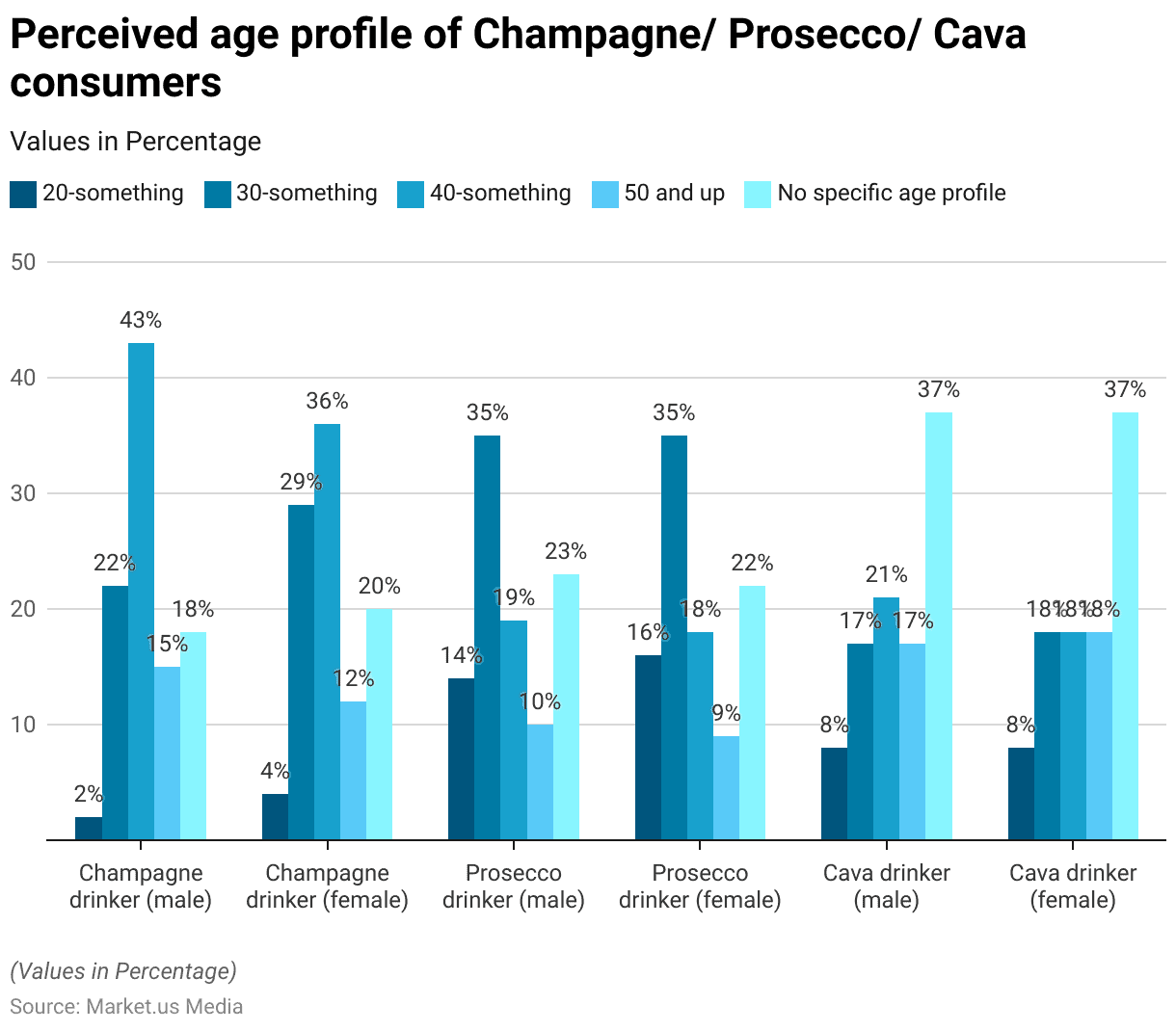
Consumer Attitudes Towards Champagne Statistics
- Consumer attitudes towards Champagne reveal a range of opinions about its pricing and value.
- A significant portion of consumers, 56%, either agree (42%) or strongly agree (14%) that Champagne is too expensive.
- Conversely, 60% of respondents would be inclined to buy more Champagne if it were cheaper, with 37% agreeing and 23% strongly agreeing with this sentiment.
- Most consumers perceive Champagne as more expensive than Prosecco or Cava, with 72% either agreeing (34%) or strongly agreeing (38%) with this statement.
- However, opinions are mixed regarding the justification of Champagne’s price; 39% believe the price is justified, split between 30% agreeing and 9% strongly agreeing, while 28% disagree or strongly disagree.
- A majority, 58%, are willing to pay more for Champagne compared to other sparkling wines such as Prosecco or Cava, with 37% agreeing and 21% strongly agreeing.
- Regarding the availability of affordable, high-quality Champagne, consumer perception shows skepticism. Only 17% believe there is good quality Champagne available for less than 10 euros, with 13% agreeing and a mere 4% strongly agreeing.
- Similarly, for Champagne under 15 euros, 44% think it is possible to find good quality, split between 31% agreeing and 13% strongly agreeing.
- This indicates that while consumers recognize Champagne as a premium product, many also feel its high price could be more justified. A substantial portion would purchase more if it were more affordable.
(Source: Formes De Luxe)
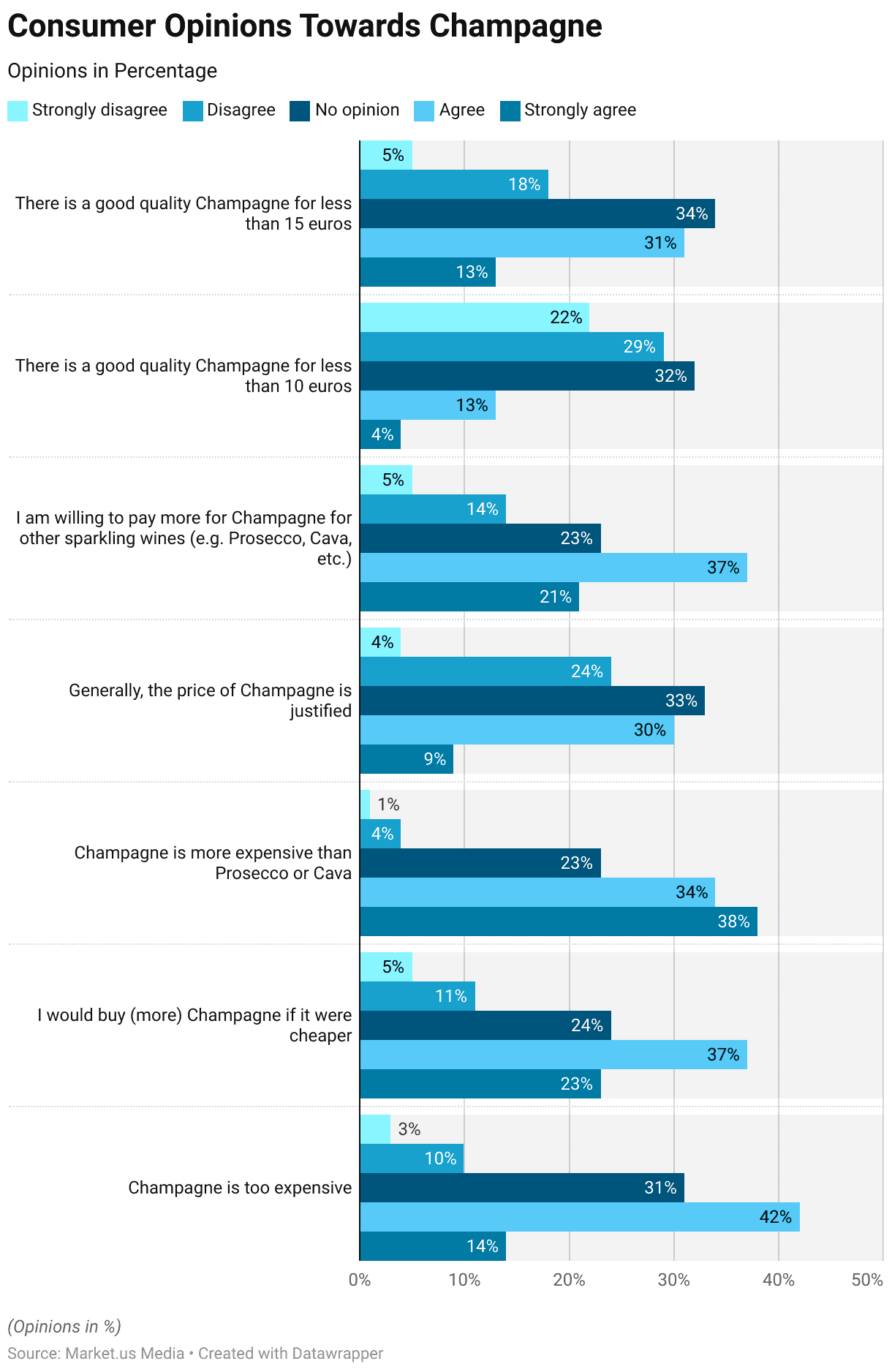
Regulations for Champagne in Various Nations Statistics
- In the EU, Champagne is protected under the Protected Designation of Origin (PDO) status. This means that only sparkling wine produced in the Champagne region of France, using specified methods (Méthode Champenoise), can be legally sold as Champagne. This regulation helps maintain the quality and uniqueness of Champagne, ensuring that consumers are purchasing genuine products.
- The U.S. follows similar protective measures but with certain exceptions. Due to pre-existing agreements, some American producers can still use the term “Champagne” if they used it before 2006. However, new producers must comply with international standards and label their products as “sparkling wine” unless it originates from the Champagne region in France.
- Japan adheres to strict import standards that align with EU regulations, recognizing that champagne is only from its French region. This has helped maintain high standards and consumer trust in the authenticity of Champagne available in the Japanese market.
- China has recently tightened its regulations around the labeling of Champagne, allowing only products imported from France’s Champagne region to be labeled as such. This move aligns China with global standards and helps protect the Champagne designation.
- Australia has agreed to phase out the use of the term “Champagne” for local products as part of its Free Trade Agreement (FTA) with the EU. This change is in recognition of the PDO status of Champagne and is intended to preserve the integrity of the Champagne brand in international markets.
(Source: Harvard University)
Recent Developments
Product Launches:
- Champagne Krug (LVMH): Introduced two new editions, “Grande Cuvées” in both white and rose, crafted from the 2014 vintage, described as an erratic year.
- Champagne Louis Roederer: Released the 2014 vintage of “Cristal” champagne, priced approximately at USD 332 for a 75 cl bottle.
Mergers and Acquisitions:
- The M&A landscape in 2024 is characterized by strategic consolidations and significant investments. For instance, notable acquisitions in related sectors like life sciences have been seen with Novo Holdings acquiring Catalent, Inc. for $16.5 billion, aiming to enhance health and sustainability outcomes.
- Suven Pharmaceuticals Limited merged with Cohance Lifesciences to broaden its market reach and comprehensively address sector demands.
Market Outlook:
- The champagne market in 2024 is marked by strategies aimed at simplification of business models, increased cross-border M&A activity, and a focus on value creation.
- This is part of a broader trend where private equity plays a vital role, especially in portfolio value creation through transformation and M&A to achieve exit returns.
Technological Innovations:
- Advances in technology and strategic partnerships are also reshaping the industry.
- For instance, Ascension partnered with WhizAI to leverage data-driven technology for improving outcomes in the life sciences.
- Which indirectly influences sectors like champagne where luxury and technology intersect.
Conclusion
Champagne Statistics – In conclusion, Champagne is distinguished not only by its geographic and production exclusivity but also by stringent international regulations that preserve its quality and authenticity.
Only sparkling wine from France’s Champagne region can be labeled as such, ensuring its integrity and heritage are maintained.
This global recognition underpins its luxury status and significant economic contribution, particularly through exports.
As markets evolve, the Champagne industry’s focus on maintaining high standards of quality and authenticity continues to be crucial for its enduring prestige and success.
FAQs
Champagne is a type of sparkling wine produced from grapes grown in the Champagne region of France under the rules of the appellation that dictate specific vineyard practices. Sourcing of grapes from designated places within Champagne, and secondary fermentation of the wine in the bottle to create carbonation.
The primary difference lies in the geographical origin and production process. Only sparkling wine made in the Champagne region of France. Using the traditional method known as “méthode champenoise” can be legally labeled as Champagne.
The main types include Non-Vintage (a blend of multiple years), Vintage (made from grapes of one single year), Blanc de Blancs (made exclusively from white grapes), Blanc de Noirs (made from black grapes), and Rosé Champagne (achieved by either blending red and white wine or macerating the juice with the skins).
Champagne is best served chilled, typically between 8°C to 10°C (46°F to 50°F). It should be poured into a tall, narrow glass such as a flute or tulip to enjoy its bubbles and aroma best.
Champagne is versatile and pairs well with a variety of foods. Classic pairings include seafood (especially oysters and shellfish), light chicken dishes, sushi, and various appetizers. Its acidity and bubbles also make it a great match for fried foods and salty snacks.
Discuss your needs with our analyst
Please share your requirements with more details so our analyst can check if they can solve your problem(s)



